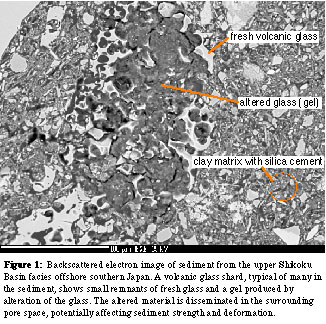
Back to Table of Contents
46682-G8
Sediment Stabilization and Anomalous Porosities Resulting from Minor Silica Cementation
Glenn A. Spinelli, New Mexico Institute of Mining and Technology
Cementation affects mechanical properties that control sediment
strength and deformation. A small volume of grain coating cement can increase
sediment strength and inhibit consolidation. Burial of cemented sediment can
generate anomalous porosities. I am examining silica cementation and the
generation of anomalous porosity in potential reservoir seal rocks, and the
controls on its spatial distribution.
A
small amount of grain-coating silica cement affects sediment properties and
deformation at Ocean Drilling Program (ODP) Sites 1173 and 1177 offshore Japan.
The cemented sediment has anomalous porosity, seismic
velocity, and rigidity. With burial and increasing temperature, failure of the
cement leads to collapse of the sediment framework and dramatic porosity loss. Previous
studies suggest that a minor amount of opal-CT cement inhibits consolidation of
the sediment at Sites 1173 and 1177. I am examining additional ODP and Deep Sea
Drilling Project (DSDP) sites offshore Japan (Sites 297, 442, 443, 444, 582), Alaska
(Site 178), California (Site 1020), and Guatemala (Site 495) to determine if
similar cementation of hemipelagic sediment is common and what effects this
cement has on sediment strength and deformation.
Sediment
samples for these circum-Pacific sites were collected from archived sediment
cores the Integrated Ocean Drilling Program core repositories. The amorphous
silica content of sediment samples from the sites is determined using an
alkaline leaching method. The nature and distribution of the cementing material
is detected through secondary and backscattered electron (SEM and BSE) images. To
date, these analyses have focused on the sites offshore Japan. Data from these
sites indicate that sediments throughout Shikoku Basin are affected by silica
cementation. The amorphous silica content of the upper Shikoku Basin facies is
higher (~1 wt% of the sediment) than in the lower Shikoku Basin facies
(<0.25 wt%). The position of the upper/lower Shikoku Basin facies boundary
appears to be controlled by silica diagenesis. In the upper Shikoku Basin
facies, amorphous silica is visible as a coating at grain contacts, filling
voids in zones of clastic material, and as altered material in contact with
volcanic glass shards. The observed amorphous silica appears to be sourced from
these volcanic glass shards. Electron microprobe analyses indicate that the
amorphous silica is nearly identical in composition to adjacent volcanic glass
shards, but with much higher porosity. Mass balance calculations indicate the
amorphous silica phase is mobile; it is disseminated throughout the surrounding
pore space and may be the material strengthening the sediment. Future work will
focus on the Alaska, California, and Guatemala sites. Understanding this
cementation process in a variety of environments will aid in the interpretation
of porosity within reservoir seal rocks.
This
grant is supporting a Native American graduate student (M.S.) at New Mexico
Tech, Mr. Russell White. In Fall 2008, he will present preliminary results of
his research at both an NSF-MARGINS sponsored workshop and at the American
Geophysical Union meeting.

Back to top




